Threats to Pangolins & Pangolin Conservation
- Richprins
- Committee Member
- Posts: 76096
- Joined: Sat May 19, 2012 3:52 pm
- Location: NELSPRUIT
- Contact:
Re: Threats to Pangolins & Pangolin Conservation
Please check Needs Attention pre-booking: https://africawild-forum.com/viewtopic.php?f=322&t=596
- RogerFraser
- Site Admin
- Posts: 6003
- Joined: Wed Sep 18, 2013 9:36 pm
- Country: South Africa
- Location: Durban
- Contact:
- Lisbeth
- Site Admin
- Posts: 67571
- Joined: Sat May 19, 2012 12:31 pm
- Country: Switzerland
- Location: Lugano
- Contact:
Re: Threats to Pangolins & Pangolin Conservation
Nigeria seeks transnational help to disrupt a still-brisk pangolin trade
by Ini Ekott on 2 September 2021
- Nigerian law enforcement officials recorded their third-biggest seizure of pangolin scales this past July, indicating that the illegal wildlife trade hasn’t been dented by the COVID-19 pandemic.
- Officials seized 7 metric tons of pangolin scales, 4.6 kilograms (10 pounds) of pangolin claws and 845 kg (1,860 lb) of elephant ivory in Lagos and arrested three foreign nationals.
- Anti-trafficking advocates have welcomed the raid, but say more needs to be done to disrupt the supply end of the trade and punish those responsible to the fullest extent of the law.
Continue to read here: https://news.mongabay.com/2021/09/niger ... 6184f5e008
by Ini Ekott on 2 September 2021
- Nigerian law enforcement officials recorded their third-biggest seizure of pangolin scales this past July, indicating that the illegal wildlife trade hasn’t been dented by the COVID-19 pandemic.
- Officials seized 7 metric tons of pangolin scales, 4.6 kilograms (10 pounds) of pangolin claws and 845 kg (1,860 lb) of elephant ivory in Lagos and arrested three foreign nationals.
- Anti-trafficking advocates have welcomed the raid, but say more needs to be done to disrupt the supply end of the trade and punish those responsible to the fullest extent of the law.
Continue to read here: https://news.mongabay.com/2021/09/niger ... 6184f5e008
"Education is the most powerful weapon which you can use to change the world." Nelson Mandela
The desire for equality must never exceed the demands of knowledge
The desire for equality must never exceed the demands of knowledge
- Richprins
- Committee Member
- Posts: 76096
- Joined: Sat May 19, 2012 3:52 pm
- Location: NELSPRUIT
- Contact:
Re: Threats to Pangolins & Pangolin Conservation
Please check Needs Attention pre-booking: https://africawild-forum.com/viewtopic.php?f=322&t=596
- Lisbeth
- Site Admin
- Posts: 67571
- Joined: Sat May 19, 2012 12:31 pm
- Country: Switzerland
- Location: Lugano
- Contact:
Re: Threats to Pangolins & Pangolin Conservation
OPERATION PANGOLIN (PART ONE)
The Sting: Meet the men and women risking their lives to save pangolin from being trafficked through a global criminal network
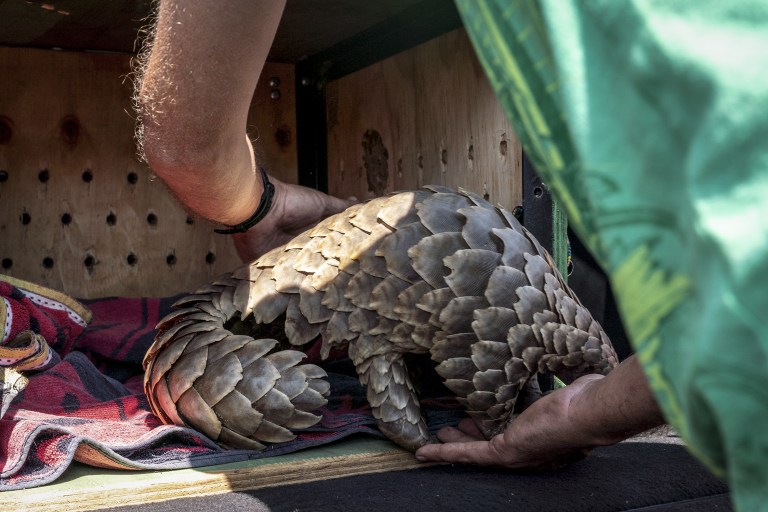
A pangolin is placed in a protective box after it was recovered in a sting operation. (Photo: Shiraaz Mohamed)
By Shiraaz Mohamed | 19 Feb 2023
Over the past few months, Daily Maverick has documented the war on pangolin poaching and the conservation of what has become the most trafficked mammal in the world. In the first of this two-part series, we follow undercover agent Professor Ray Jansen and a group of brave men and women who are on a mission to save these creatures.
________________________________________________________________________________________________________________________
‘OK, I see the second one now. Got you. My rearview mirror is on them … I see them perfectly…
“Get ready,” the operative says. “Get ready.”
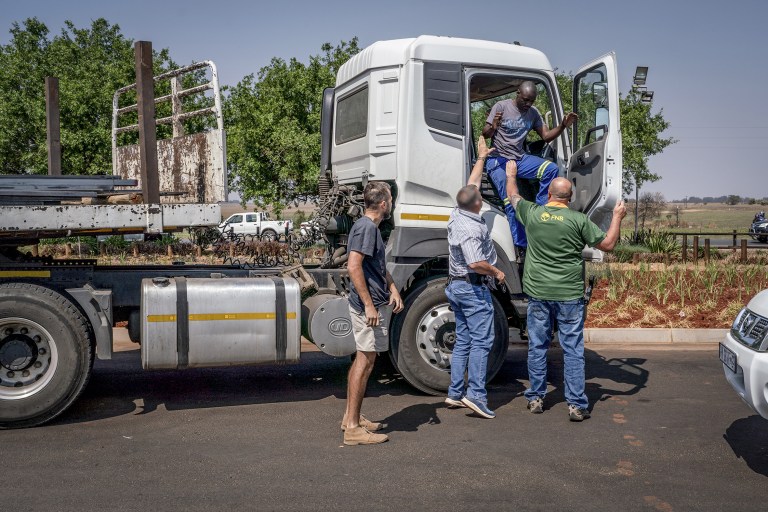
Law enforcement officials pull a driver from the cab of his truck in a sting operation. (Photo: Shiraaz Mohamed)
Moments later, he bursts out of the door of his vehicle parked metres away from where the transaction is taking place. With lightning speed, Professor Ray Jansen sprints towards two suspects. The signal for the takedown has been given. The sound of police sirens reverberates through the air followed by screeching tyres as more officials move in.
Jansen is a pangolin expert who has dedicated his life to this mammal’s conservation, and who through a Section 252a authority – a court endorsement to stage stings and entrapment operations – works as an undercover agent for the state posing as a pangolin buyer.
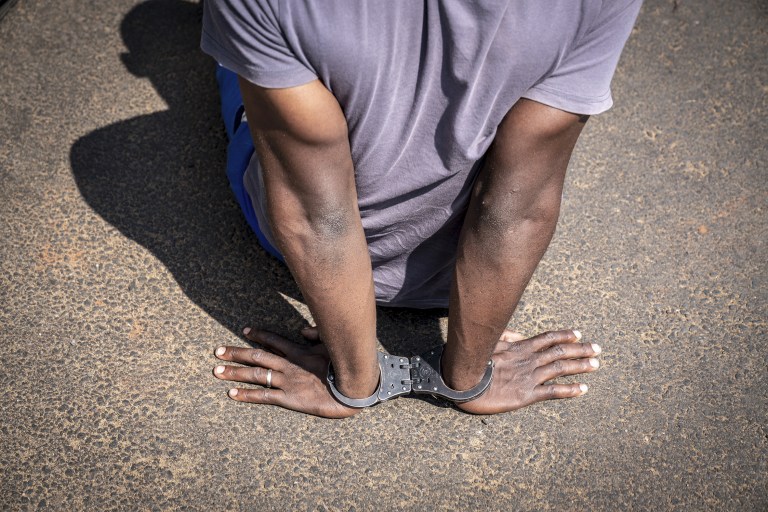
A truck driver from Zimbabwe is arrested in a sting after trying to sell a pangolin. (Photo: Shiraaz Mohamed)/size]
For months Daily Maverick has shadowed him as he and other brave men and women tracked syndicates, staged buys and conducted sting operations to arrest the people trafficking pangolin from Africa to Asia.
“It’s a lot of these people that we catch on the ground. The same people that are involved in smuggling drugs such as Mandrax, heroin and cocaine are also heavily involved in wildlife trafficking, trafficking in rhino horn, elephant ivory, pangolin scales and abalone (commonly known as perlemoen). And I’ve seen more and more of this in recent years, where syndicates are involved, and they often offer me elephant ivory, rhino horn and blood diamonds in the same transaction, as they would with pangolins,” Jansen says.
Back at the scene of the takedown, the first suspect is pinned down by two officers. The second tries to flee and puts up a fight. It takes six guys to pin him down. They don’t take any chances, so his legs and hands are tied with thick, blue cable ties.
In the back of the Nissan NP200 bakkie, Jansen inspects the pangolin kept in a cardboard box. “I’m shaking too much, it’s all blurred.” He says as he climbs out, indicating that he needs help to remove the pangolin. An Environmental Management Inspector from Gauteng, from a unit commonly referred to as the Green Scorpions, clambers into the rear of the vehicle to take photographs and retrieve the pangolin.
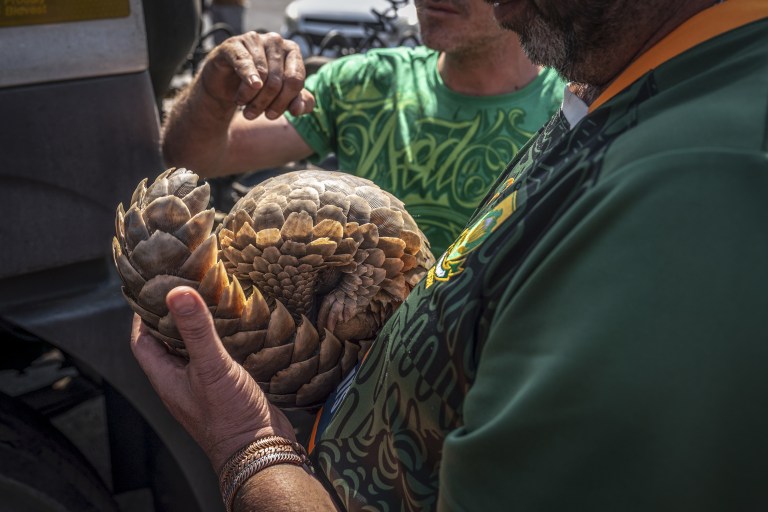
Officials examine a pangolin rescued in a sting operation. (Photo: Shiraaz Mohamed)
Outside, the first suspect is protesting his innocence, “Brothers forgive me, I did not know this, Bozza [boss]. I don’t resist, neh. I am really cooperative. Please forgive me. I am really cooperative with you, brothers.”
Jansen rests his hands on the man’s shoulders and as if comforting him says, “It’s all right, bru; it’s all right, man.”
“I am trying to save them (the pangolin). I want to leave them in the wild; they are very endangered. They are going to all die, so I have to try and save them,” Jansen tells the man, who is now offering to take him to Kuruman where more pangolins are allegedly being moved.
The man’s pleas go unheard and he and his accomplice are taken to a nearby police station where they are charged with wildlife trafficking and contravening the National Environmental Management Biodiversity Act.
A large group of people has gathered, curious to know what has happened. Jansen calls them closer and explains the significance of the pangolin and its cultural values. He tells them they are endangered and explains why the suspects were arrested. They are allowed to take photographs of the pangolin and are encouraged to go back to their communities and spread the word to create awareness.
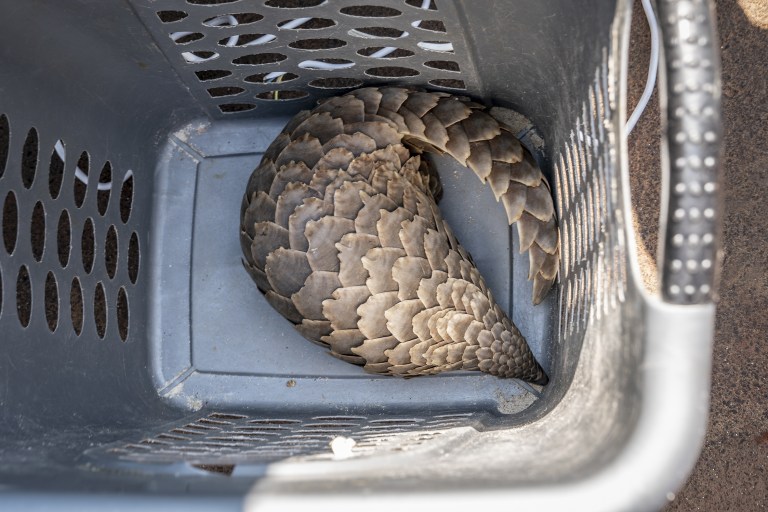
A pangolin kept in a washing basket is rescued in a sting operation. (Photo: Shiraaz Mohamed)
Inside the box, the pangolin shows no visible signs of distress, but it later dies of organ failure at the Johannesburg Wildlife Veterinary Hospital where it is taken for treatment.
Medicinal value
For thousands of years, people have used natural products for their medicinal value. The practice of using plant and animal-based products continues today. In the Far East, pangolins are at the top of the list. More than 60 products contain pangolin scales, either dried or crushed into a powder and made into tablets, creating a huge market for their scales.
The same substance that makes up fingernails, hair and horn also makes up pangolin scales: keratin. While pangolin scales and rhino horn have no proven medical benefits, traditional Chinese medicine uses them to treat conditions ranging from arthritis to breastfeeding problems.
In Asia, particularly in countries such as Vietnam, pangolin meat is considered a delicacy.
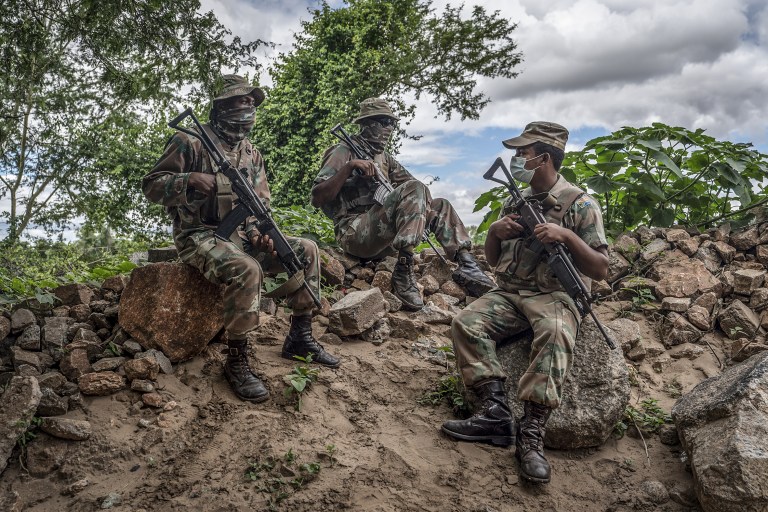
A file photo showing soldiers on patrol close to the Beit Bridge Border. Despite the presence of law enforcement officials, a large number of pangolins are smuggled into South Africa from Zimbabwe. (Photo: Shiraaz Mohamed)
In South Africa, some local customs claim pangolins can guard against evil, bring good luck and be used as love charms. The sought-after body parts include the scales, blood, meat, bones, claws and skin. It is claimed, though not scientifically proven, that pangolin parts can cure nose bleeds, high blood pressure, ear aches, diabetes, HIV/Aids, sexually transmitted diseases, rheumatism, chest pains, back pains and liver cancer.
In West Africa, some people believe the pangolin cures and treats financial difficulties, mental illness, miscarriage, menstrual pain and infertility and offers protection against witchcraft.
Catching poachers
Mike* (*not his real name) is an undercover agent based in Limpopo. He works closely with Jansen, the conservationist group Transfrontier Africa, the police, the Limpopo Endangered Species Unit, local anti-poaching teams as well as local community policing forums.
Despite many pangolins being harvested within South Africa, most of those that Mike and his team intercept are smuggled into South Africa from Zimbabwe. The pangolins are sourced by a local, who then reaches out to someone in the trade, and the word is put out that pangolins are on the market.
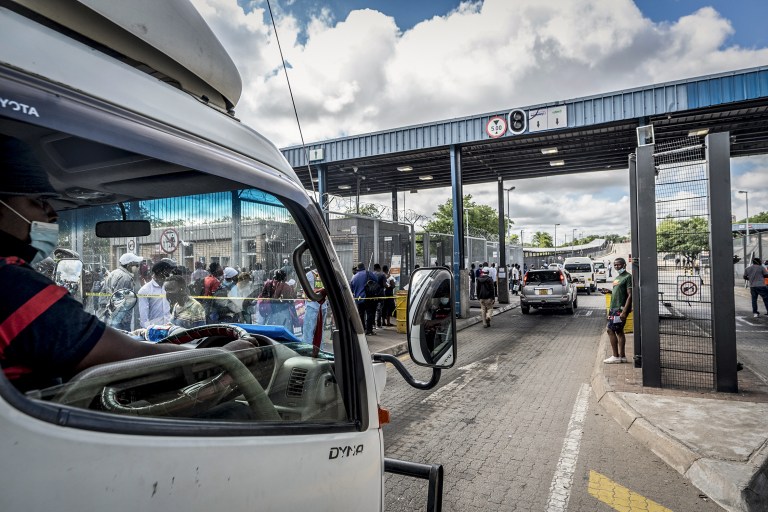
Often multiple groups are linked to a central figure who will try to sell the same pangolin, Mike explains.
“The arrests are normally always big. They’re always four or five people because that is the grouping, and that grouping will have friends with other people. We’ve managed to take down three different groups, all connected via the same individual, who sits in Zimbabwe. He sends the pangolins to his different connections in South Africa and he controls it.
“We’ve followed him on WhatsApp, because he uses his status as a marketplace. He’s put cellphones, laptops, TVs, all sorts of things for sale on it. And he puts pangolins on it as well for a short time, but he puts them through and then generally you find it filtering through the market, where you’ll find the same pangolin coming from four or five different groups, different angles, etc, all with different pricing.”
In a recent bust, Mike and his team intercepted a deal that was being facilitated from KwaZulu-Natal. The seller travelled to Johannesburg to collect a pangolin smuggled from Zimbabwe and made his way to Limpopo where he tried to sell the pangolin, before he was arrested.
Trade routes
For many years, poachers and traffickers focused mostly on Asian species. However, since their numbers have dwindled, traffickers have turned to African pangolins. According to Mike, corrupt officials – including police and SARS customs officials – all play a part in the illegal trade.
Jansen says middlemen working for syndicates collect the pangolins after they have been harvested. They are collected either alive or their scales are collected. Very rarely are individual mammals involved.
The “cargo” is moved from South Africa to a port in another country such as Maputo in Mozambique, where customs duties and the policing system are often more lax than at South African harbours. Using incorrect labels, the cargo is loaded on to shipping containers and smuggled to ports in Malaysia, Vietnam and Hong Kong.
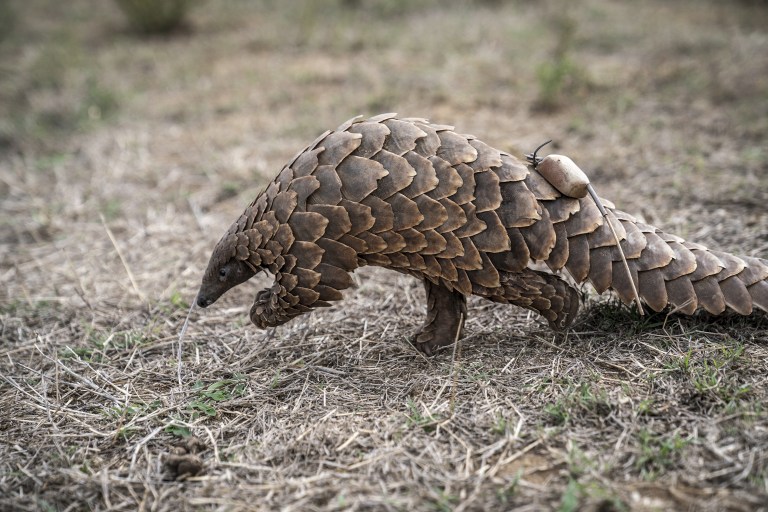
A tag as seen on a rescued pangolin. Tags aid in recording the movement of these animals. (Photo: Shiraaz Mohamed)
The shipment is then sold to a manufacturing company which processes the scales into a powder and eventually into various forms of medicines. According to the investigators, up to six or seven transactions take place, from the time the mammal is harvested in Africa until it reaches Asia.
“Each time this transaction takes place, the value of the animal increases. And then the end value is what [makes] it this perceived very, very expensive commodity. And that’s the word on the ground. It’s not always the end value that is collected on the ground. It’s a hell of a lot less. But that’s where the negotiation starts because each person in this commodity chain wants to make money. So what he pays for it or she pays for it, they want to sell it at an advanced value,” Jansen explains.
According to the African Wildlife Foundation, pangolin prices are on the rise, fetching $600 a kilogram today compared to $14 a kilogram in the 1990s.
Continental drift
Nigeria is considered to be the epicentre of the pangolin crisis. According to reports, criminal networks in Nigeria have secured the majority of the African pangolin trade as a result of the country’s porous borders, its low level of law enforcement, corruption, and because it has one of the largest ports on the continent, Lagos.
The Environmental Investigation Agency reports that, between 2015 and 2021, 167 tons of pangolin parts (equivalent to 167,000 pangolins) originating from Nigeria were seized worldwide.
“We keep a record of what we hear about that’s intercepted. So if there’s been 5kg or 10kg, we probably won’t hear about it.
“But those big hauls of 250kg or a ton of scales, are the ones we hear about, but the large majority we do not hear about. So if you’re talking about that level of trade of pangolin scales going to Asia, for a mammal that only has one pup every year or possibly only every second year, the off-take far exceeds the pace of natural reproduction for the species. That basically means the population is in a major negative decline,” says Jansen, who estimates that the animals may be extinct in the next 20 years.
Scales of injustice
Although it’s not as prevalent as in West Africa, South African government officials have also been caught with their hands in the honey jar. According to Jansen, during five separate busts, policemen have been arrested. “On one occasion, just south of Polokwane, a Deputy Director of Agriculture for Limpopo was arrested. That trial is still pending.”
In 2019, Zwiitwaho Ian Maphiri, employed by the Limpopo Department of Agriculture and Rural Development as its Deputy Director of Corporate Communications, was found in possession of a pangolin in the boot of his BMW. The case is still ongoing, and a reliable source told Daily Maverick the docket had to be moved to a secure location as there were attempts to make the docket “disappear”.
Sting operations are ongoing, not only with Jansen and his team, but also with various law enforcement units. Earlier this year, Lieutenant-Colonel RR Ryland and his team of the Johannesburg police’s tactical response Team, working on intelligence from Crime Intelligence, swooped on three suspects in Cosmos City, rescuing two pangolins, which were handed over to the Johannesburg Wildlife Veterinary Hospital for treatment.

Col RR Ryland (right) and his team after the arrest of three suspects in Cosmos City, Johannesburg. Two pangolins were recovered during their operation. (Photo: Shiraaz Mohamed)
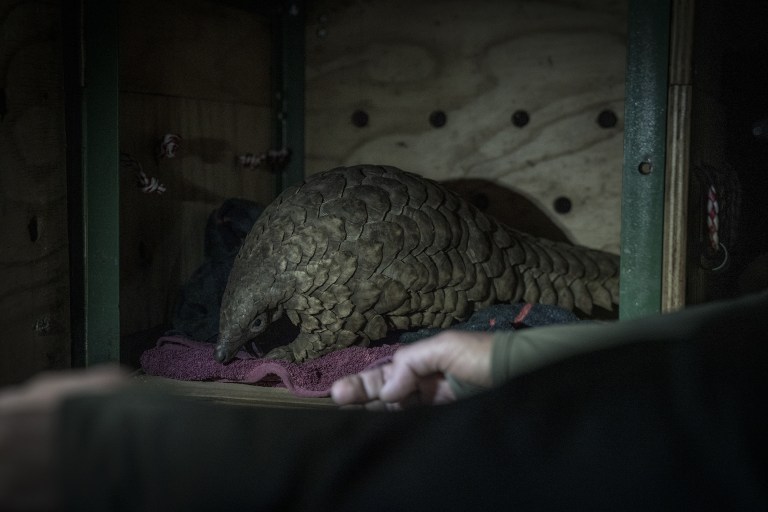
A rescued pangolin about to be transported to the Johannesburg Wildlife Veterinary Hospital after members of the Johannesburg Tactical Response Team and Criminal Intelligence units received information about suspected poachers in Cosmos City, Johannesburg. Three suspects were arrested. (Photo: Shiraaz Mohamed)
Since 2015, 156 criminal cases involving the illegal pangolin trade have been opened in South Africa, most in Gauteng and Limpopo. Only half of these cases have been finalised and to date the harshest sentence handed down is 10 years in a Pretoria court. Previously, sentences handed down were in the form of a fine, usually between R500 and R1,000.
Traditional Chinese Medicine (TCM) list
Despite conservationists around the world breathing a sigh of relief in 2020 when pangolin scales were removed from the list of Chinese traditional medicines, the illegal trade continues to flourish.
Jansen explains that the ban only applies to non-patented products. “Now, there’s the loophole, if your product is patented, and ingredients form part of that patent they are exempt from that rule. So what happens? You just start patenting more products.”
He says another loophole allows existing stockpiles to be exempt.
But Jansen asks, “How do you know when (a stockpile) is going to be depleted? How do you know that you’re not adding fresh pangolin continuously to the stockpile? It’s not being monitored … The market is booming, you just don’t declare it. It’s all underground. Everything is now underground.”
According to industry information publisher IBISWorld, the TCM-manufacturing industry in China has grown 4.1% on average between 2017 and 2022 and is worth $47.4-billion.
Jansen believes pangolins were possibly removed from the list of animals granted use in traditional medicine because of the embarrassment from the SARS Covid-19 outbreak, which was thought to have possibly originated from an Asian species of pangolin sold in a wet market in Wuhan, China.
Death threats
Jansen has been living a covert life for the past few years, much to the anguish of his family. Despite receiving death threats, he has continued in his fight to save the pangolin.
A former specialist infantry soldier in the South African border war, he has seen combat and describes each night before a sting operation as similar to preparing for a battle.
“There is nausea, you don’t sleep. It’s like going into combat. It’s exactly the same thing. These are the emotions that you have to deal with. Your adrenaline and certain feelings of PTSD come about…
“Each operation I’m on, I still remember them vividly. Every single one, I can smell it, I can taste it, I can still be there. And there comes a point that you can’t anymore. It’s just, it’s all too much and that’s when you have to do something else, or else you’re going to lose it,” Jansen says, describing his mental state after years of acting as an agent. He now feels that the time has come for him to retire.
“It does become more dangerous for me and my family. The police have to take over and they have to do what they’re good at. It becomes more difficult for a member of the public to be involved in this, we can call it a war, which is a problem,” he says. DM/OBP
The Sting: Meet the men and women risking their lives to save pangolin from being trafficked through a global criminal network

A pangolin is placed in a protective box after it was recovered in a sting operation. (Photo: Shiraaz Mohamed)
By Shiraaz Mohamed | 19 Feb 2023
Over the past few months, Daily Maverick has documented the war on pangolin poaching and the conservation of what has become the most trafficked mammal in the world. In the first of this two-part series, we follow undercover agent Professor Ray Jansen and a group of brave men and women who are on a mission to save these creatures.
________________________________________________________________________________________________________________________
‘OK, I see the second one now. Got you. My rearview mirror is on them … I see them perfectly…
“Get ready,” the operative says. “Get ready.”

Law enforcement officials pull a driver from the cab of his truck in a sting operation. (Photo: Shiraaz Mohamed)
Moments later, he bursts out of the door of his vehicle parked metres away from where the transaction is taking place. With lightning speed, Professor Ray Jansen sprints towards two suspects. The signal for the takedown has been given. The sound of police sirens reverberates through the air followed by screeching tyres as more officials move in.
Jansen is a pangolin expert who has dedicated his life to this mammal’s conservation, and who through a Section 252a authority – a court endorsement to stage stings and entrapment operations – works as an undercover agent for the state posing as a pangolin buyer.

A truck driver from Zimbabwe is arrested in a sting after trying to sell a pangolin. (Photo: Shiraaz Mohamed)/size]
For months Daily Maverick has shadowed him as he and other brave men and women tracked syndicates, staged buys and conducted sting operations to arrest the people trafficking pangolin from Africa to Asia.
“It’s a lot of these people that we catch on the ground. The same people that are involved in smuggling drugs such as Mandrax, heroin and cocaine are also heavily involved in wildlife trafficking, trafficking in rhino horn, elephant ivory, pangolin scales and abalone (commonly known as perlemoen). And I’ve seen more and more of this in recent years, where syndicates are involved, and they often offer me elephant ivory, rhino horn and blood diamonds in the same transaction, as they would with pangolins,” Jansen says.
Back at the scene of the takedown, the first suspect is pinned down by two officers. The second tries to flee and puts up a fight. It takes six guys to pin him down. They don’t take any chances, so his legs and hands are tied with thick, blue cable ties.
In the back of the Nissan NP200 bakkie, Jansen inspects the pangolin kept in a cardboard box. “I’m shaking too much, it’s all blurred.” He says as he climbs out, indicating that he needs help to remove the pangolin. An Environmental Management Inspector from Gauteng, from a unit commonly referred to as the Green Scorpions, clambers into the rear of the vehicle to take photographs and retrieve the pangolin.

Officials examine a pangolin rescued in a sting operation. (Photo: Shiraaz Mohamed)
Outside, the first suspect is protesting his innocence, “Brothers forgive me, I did not know this, Bozza [boss]. I don’t resist, neh. I am really cooperative. Please forgive me. I am really cooperative with you, brothers.”
Jansen rests his hands on the man’s shoulders and as if comforting him says, “It’s all right, bru; it’s all right, man.”
“I am trying to save them (the pangolin). I want to leave them in the wild; they are very endangered. They are going to all die, so I have to try and save them,” Jansen tells the man, who is now offering to take him to Kuruman where more pangolins are allegedly being moved.
The man’s pleas go unheard and he and his accomplice are taken to a nearby police station where they are charged with wildlife trafficking and contravening the National Environmental Management Biodiversity Act.
A large group of people has gathered, curious to know what has happened. Jansen calls them closer and explains the significance of the pangolin and its cultural values. He tells them they are endangered and explains why the suspects were arrested. They are allowed to take photographs of the pangolin and are encouraged to go back to their communities and spread the word to create awareness.

A pangolin kept in a washing basket is rescued in a sting operation. (Photo: Shiraaz Mohamed)
Inside the box, the pangolin shows no visible signs of distress, but it later dies of organ failure at the Johannesburg Wildlife Veterinary Hospital where it is taken for treatment.
Medicinal value
For thousands of years, people have used natural products for their medicinal value. The practice of using plant and animal-based products continues today. In the Far East, pangolins are at the top of the list. More than 60 products contain pangolin scales, either dried or crushed into a powder and made into tablets, creating a huge market for their scales.
The same substance that makes up fingernails, hair and horn also makes up pangolin scales: keratin. While pangolin scales and rhino horn have no proven medical benefits, traditional Chinese medicine uses them to treat conditions ranging from arthritis to breastfeeding problems.
In Asia, particularly in countries such as Vietnam, pangolin meat is considered a delicacy.

A file photo showing soldiers on patrol close to the Beit Bridge Border. Despite the presence of law enforcement officials, a large number of pangolins are smuggled into South Africa from Zimbabwe. (Photo: Shiraaz Mohamed)
In South Africa, some local customs claim pangolins can guard against evil, bring good luck and be used as love charms. The sought-after body parts include the scales, blood, meat, bones, claws and skin. It is claimed, though not scientifically proven, that pangolin parts can cure nose bleeds, high blood pressure, ear aches, diabetes, HIV/Aids, sexually transmitted diseases, rheumatism, chest pains, back pains and liver cancer.
In West Africa, some people believe the pangolin cures and treats financial difficulties, mental illness, miscarriage, menstrual pain and infertility and offers protection against witchcraft.
Catching poachers
Mike* (*not his real name) is an undercover agent based in Limpopo. He works closely with Jansen, the conservationist group Transfrontier Africa, the police, the Limpopo Endangered Species Unit, local anti-poaching teams as well as local community policing forums.
Despite many pangolins being harvested within South Africa, most of those that Mike and his team intercept are smuggled into South Africa from Zimbabwe. The pangolins are sourced by a local, who then reaches out to someone in the trade, and the word is put out that pangolins are on the market.

Often multiple groups are linked to a central figure who will try to sell the same pangolin, Mike explains.
“The arrests are normally always big. They’re always four or five people because that is the grouping, and that grouping will have friends with other people. We’ve managed to take down three different groups, all connected via the same individual, who sits in Zimbabwe. He sends the pangolins to his different connections in South Africa and he controls it.
“We’ve followed him on WhatsApp, because he uses his status as a marketplace. He’s put cellphones, laptops, TVs, all sorts of things for sale on it. And he puts pangolins on it as well for a short time, but he puts them through and then generally you find it filtering through the market, where you’ll find the same pangolin coming from four or five different groups, different angles, etc, all with different pricing.”
In a recent bust, Mike and his team intercepted a deal that was being facilitated from KwaZulu-Natal. The seller travelled to Johannesburg to collect a pangolin smuggled from Zimbabwe and made his way to Limpopo where he tried to sell the pangolin, before he was arrested.
Trade routes
For many years, poachers and traffickers focused mostly on Asian species. However, since their numbers have dwindled, traffickers have turned to African pangolins. According to Mike, corrupt officials – including police and SARS customs officials – all play a part in the illegal trade.
Jansen says middlemen working for syndicates collect the pangolins after they have been harvested. They are collected either alive or their scales are collected. Very rarely are individual mammals involved.
The “cargo” is moved from South Africa to a port in another country such as Maputo in Mozambique, where customs duties and the policing system are often more lax than at South African harbours. Using incorrect labels, the cargo is loaded on to shipping containers and smuggled to ports in Malaysia, Vietnam and Hong Kong.

A tag as seen on a rescued pangolin. Tags aid in recording the movement of these animals. (Photo: Shiraaz Mohamed)
The shipment is then sold to a manufacturing company which processes the scales into a powder and eventually into various forms of medicines. According to the investigators, up to six or seven transactions take place, from the time the mammal is harvested in Africa until it reaches Asia.
“Each time this transaction takes place, the value of the animal increases. And then the end value is what [makes] it this perceived very, very expensive commodity. And that’s the word on the ground. It’s not always the end value that is collected on the ground. It’s a hell of a lot less. But that’s where the negotiation starts because each person in this commodity chain wants to make money. So what he pays for it or she pays for it, they want to sell it at an advanced value,” Jansen explains.
According to the African Wildlife Foundation, pangolin prices are on the rise, fetching $600 a kilogram today compared to $14 a kilogram in the 1990s.
Continental drift
Nigeria is considered to be the epicentre of the pangolin crisis. According to reports, criminal networks in Nigeria have secured the majority of the African pangolin trade as a result of the country’s porous borders, its low level of law enforcement, corruption, and because it has one of the largest ports on the continent, Lagos.
The Environmental Investigation Agency reports that, between 2015 and 2021, 167 tons of pangolin parts (equivalent to 167,000 pangolins) originating from Nigeria were seized worldwide.
“We keep a record of what we hear about that’s intercepted. So if there’s been 5kg or 10kg, we probably won’t hear about it.
“But those big hauls of 250kg or a ton of scales, are the ones we hear about, but the large majority we do not hear about. So if you’re talking about that level of trade of pangolin scales going to Asia, for a mammal that only has one pup every year or possibly only every second year, the off-take far exceeds the pace of natural reproduction for the species. That basically means the population is in a major negative decline,” says Jansen, who estimates that the animals may be extinct in the next 20 years.
Scales of injustice
Although it’s not as prevalent as in West Africa, South African government officials have also been caught with their hands in the honey jar. According to Jansen, during five separate busts, policemen have been arrested. “On one occasion, just south of Polokwane, a Deputy Director of Agriculture for Limpopo was arrested. That trial is still pending.”
In 2019, Zwiitwaho Ian Maphiri, employed by the Limpopo Department of Agriculture and Rural Development as its Deputy Director of Corporate Communications, was found in possession of a pangolin in the boot of his BMW. The case is still ongoing, and a reliable source told Daily Maverick the docket had to be moved to a secure location as there were attempts to make the docket “disappear”.
Sting operations are ongoing, not only with Jansen and his team, but also with various law enforcement units. Earlier this year, Lieutenant-Colonel RR Ryland and his team of the Johannesburg police’s tactical response Team, working on intelligence from Crime Intelligence, swooped on three suspects in Cosmos City, rescuing two pangolins, which were handed over to the Johannesburg Wildlife Veterinary Hospital for treatment.

Col RR Ryland (right) and his team after the arrest of three suspects in Cosmos City, Johannesburg. Two pangolins were recovered during their operation. (Photo: Shiraaz Mohamed)

A rescued pangolin about to be transported to the Johannesburg Wildlife Veterinary Hospital after members of the Johannesburg Tactical Response Team and Criminal Intelligence units received information about suspected poachers in Cosmos City, Johannesburg. Three suspects were arrested. (Photo: Shiraaz Mohamed)
Since 2015, 156 criminal cases involving the illegal pangolin trade have been opened in South Africa, most in Gauteng and Limpopo. Only half of these cases have been finalised and to date the harshest sentence handed down is 10 years in a Pretoria court. Previously, sentences handed down were in the form of a fine, usually between R500 and R1,000.
Traditional Chinese Medicine (TCM) list
Despite conservationists around the world breathing a sigh of relief in 2020 when pangolin scales were removed from the list of Chinese traditional medicines, the illegal trade continues to flourish.
Jansen explains that the ban only applies to non-patented products. “Now, there’s the loophole, if your product is patented, and ingredients form part of that patent they are exempt from that rule. So what happens? You just start patenting more products.”
He says another loophole allows existing stockpiles to be exempt.
But Jansen asks, “How do you know when (a stockpile) is going to be depleted? How do you know that you’re not adding fresh pangolin continuously to the stockpile? It’s not being monitored … The market is booming, you just don’t declare it. It’s all underground. Everything is now underground.”
According to industry information publisher IBISWorld, the TCM-manufacturing industry in China has grown 4.1% on average between 2017 and 2022 and is worth $47.4-billion.
Jansen believes pangolins were possibly removed from the list of animals granted use in traditional medicine because of the embarrassment from the SARS Covid-19 outbreak, which was thought to have possibly originated from an Asian species of pangolin sold in a wet market in Wuhan, China.
Death threats
Jansen has been living a covert life for the past few years, much to the anguish of his family. Despite receiving death threats, he has continued in his fight to save the pangolin.
A former specialist infantry soldier in the South African border war, he has seen combat and describes each night before a sting operation as similar to preparing for a battle.
“There is nausea, you don’t sleep. It’s like going into combat. It’s exactly the same thing. These are the emotions that you have to deal with. Your adrenaline and certain feelings of PTSD come about…
“Each operation I’m on, I still remember them vividly. Every single one, I can smell it, I can taste it, I can still be there. And there comes a point that you can’t anymore. It’s just, it’s all too much and that’s when you have to do something else, or else you’re going to lose it,” Jansen says, describing his mental state after years of acting as an agent. He now feels that the time has come for him to retire.
“It does become more dangerous for me and my family. The police have to take over and they have to do what they’re good at. It becomes more difficult for a member of the public to be involved in this, we can call it a war, which is a problem,” he says. DM/OBP
"Education is the most powerful weapon which you can use to change the world." Nelson Mandela
The desire for equality must never exceed the demands of knowledge
The desire for equality must never exceed the demands of knowledge
- Lisbeth
- Site Admin
- Posts: 67571
- Joined: Sat May 19, 2012 12:31 pm
- Country: Switzerland
- Location: Lugano
- Contact:
Re: Threats to Pangolins & Pangolin Conservation
OPERATION PANGOLIN (PART TWO)
Back to the wild: The painstaking, often heartbreaking process of returning poached pangolins to their natural habitat
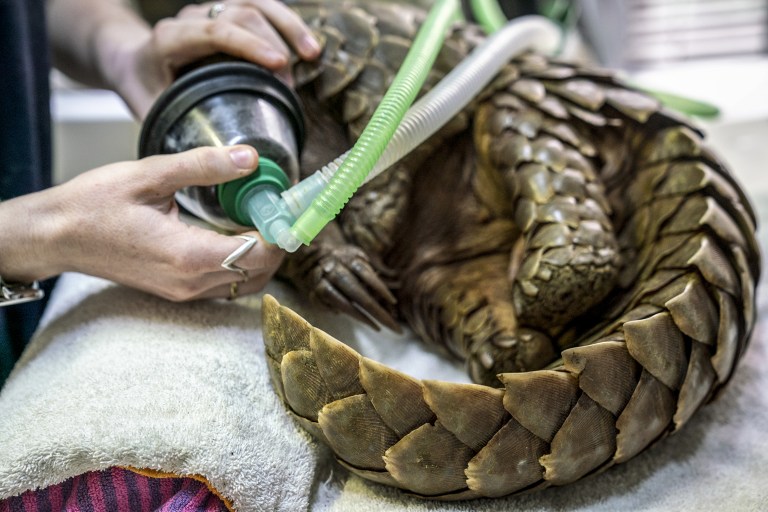
A rescued pangolin receives treatment. (Photo: Shiraaz Mohamed)
By Shiraaz Mohamed | 19 Feb 2023
In part two of our series on pangolin poaching, we look at what it takes to rehabilitate and release back into the wild a pangolin rescued from the illegal wildlife trade.
_________________________________________________________________________________________________________________________
It’s late at night and researcher Francois Meyer and wildlife monitor Hannah Sharp stand in the bush on a Big Five game reserve in the heart of Limpopo. They have been waiting since early afternoon for Bumper, a young sub-adult male pangolin, to come out of his burrow so they can weigh him and collect scat (faecal droppings) samples for Meyer’s research.
Read Part one above: The Sting: Meet the men and women risking their lives to save pangolin from being trafficked through a global criminal network
Meyer holds a master’s degree in zoology and is currently working towards a PhD focusing on pangolins rescued from the illegal wildlife trade with a particular interest in how captivity, rehabilitation and release affect the animals’ stress levels compared with the stress they experience in their natural environment.
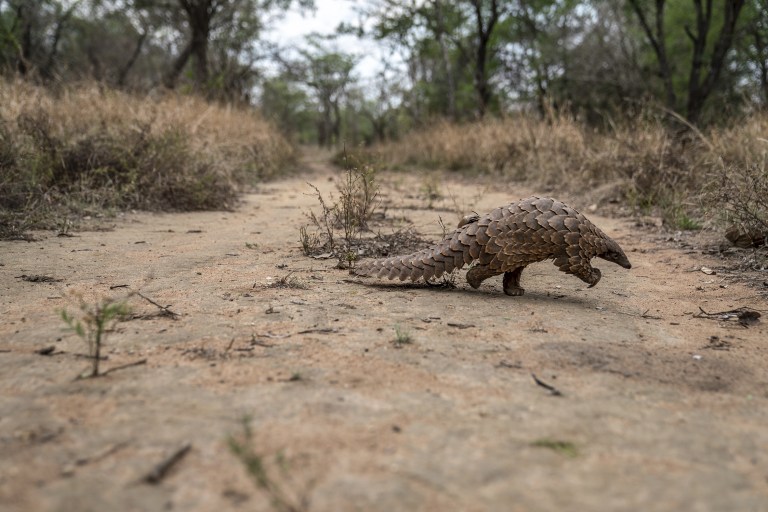
A rescued pangolin forages for food in Limpopo. (Photo: Shiraaz Mohamed)
On the reserve, the only source of light comes from their cellphones and torches. Being on a Big Five game reserve makes them vulnerable to animal encounters. Meyer has had close encounters with a cheetah as well as an elephant bull in musth. While Meyer escaped unscathed, the bull damaged his Land Rover.
“Don’t worry, if there is any sign of trouble, we will pick it up on Silver’s behaviour,” Meyer assures Daily Maverick, as he smiles at his dog.
Bumper eventually makes his way out of his burrow, and Meyer and Sharp follow from a distance. They wait for the ideal moment to collect his scat samples and to measure his weight. But Bumper makes his way to a new burrow and settles in. Moments later a storm hits. Although disappointed that he was unable to collect his samples, Meyer seems delighted at Bumper’s behaviour. “It is as if he knew the storm was coming, so he went into a more suited burrow,” Meyer says.
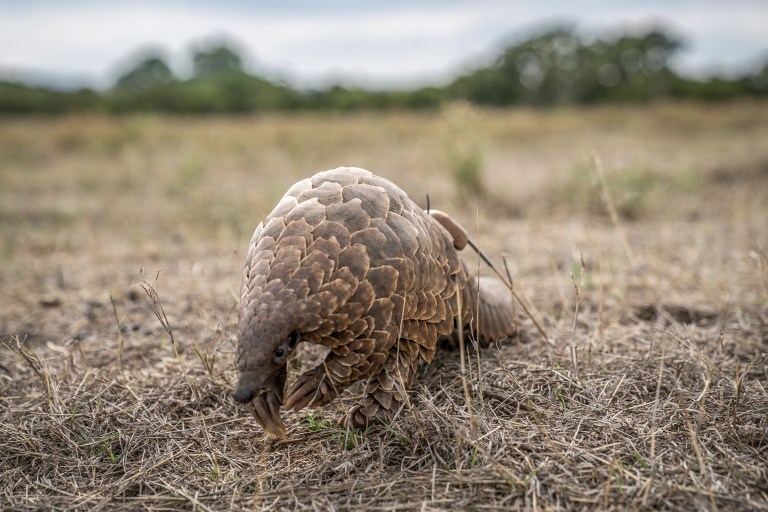
A pangolin forage usually lasts five to six hours. (Photo: Shiraaz Mohamed)
Bumper is one of hundreds of pangolins rescued from the illegal wildlife trade. He was intercepted at the Beitbridge Border Post after a poacher tried to smuggle him into South Africa from Zimbabwe. He was flown by helicopter to receive specialist medical care and was eventually released into the bush as part of his soft release programme. Bumper is named after the good Samaritan who sponsored the fuel for his flight.
“I’m very glad to report Bumper is doing really well and is adapting to the field. His behaviour is super healthy. Because he’s had human contact in the care of rehabilitation and the release process, he was habituated to humans. But now he’s losing his patience with people, which is fantastic because he’s losing that habituation and his wild instincts are on point,” says Meyer, whose testimony in court helped convict Bumper’s poacher. The poacher is now serving a six-year jail sentence.
Abuse in captivity
It doesn’t always go so well.
Pangolins rescued from poachers are often put under a huge amount of stress as they are subjected to all sorts of abuse while in captivity.
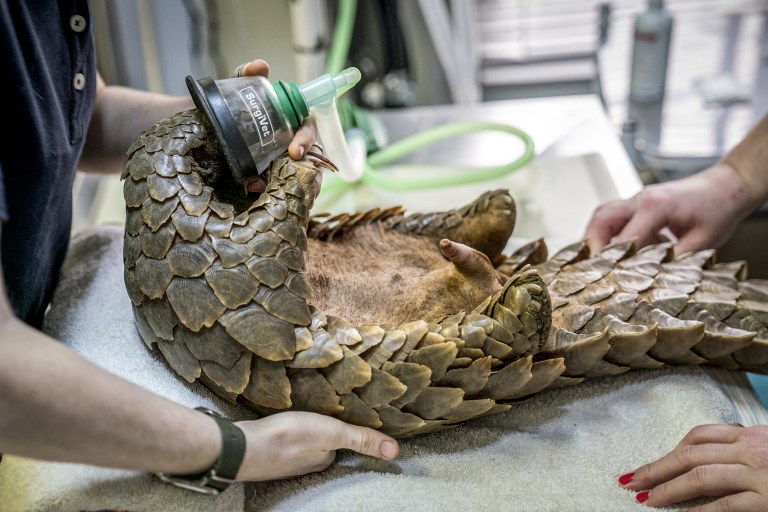
A rescued pangolin is anaesthetised before it is tube fed. (Photo: Shiraaz Mohamed)
For weeks at a time, they can be kept in the boots of cars, in boxes, wired mesh structures, bags and rucksacks, washing baskets and cardboard boxes. Some are covered in diesel or petrol, or strong-smelling substances, to go undetected by sniffer dogs. They are sometimes tied up so they cannot escape and there have been cases of their limbs being cut off to prevent them from escaping.
Read more in Daily Maverick: “Standing up for the pangolin, the world’s most trafficked mammal”
Glen Thompson, a pangolin specialist for the conservationist group Transfrontier Africa, recounts how he encountered a pangolin with a missing foreleg. The pangolin was found at a roadblock in Hammanskraal.
“I took the animal to hospital and as we tried to anaesthetise it to assess it, we discovered its right forearm was missing. There were maggot larvae and the distinct smell of decaying flesh … I was in tears, I had to actually leave the theatre room. Even though it was the most humane thing (euthanising it) to do, it was heartbreaking. It is the most severe case I have seen. I have dealt with horrific cases, but this to me sticks out in my memory the most. Just the pain and suffering it went through.”
Specialist treatment
Pangolins that are rescued in sting operations are taken to specialist hospitals or veterinarians for assessment and treatment before they are released back into the wild.
Provet, a specialist practice in Limpopo, serves as a first-response vet for many sting operations in the area.
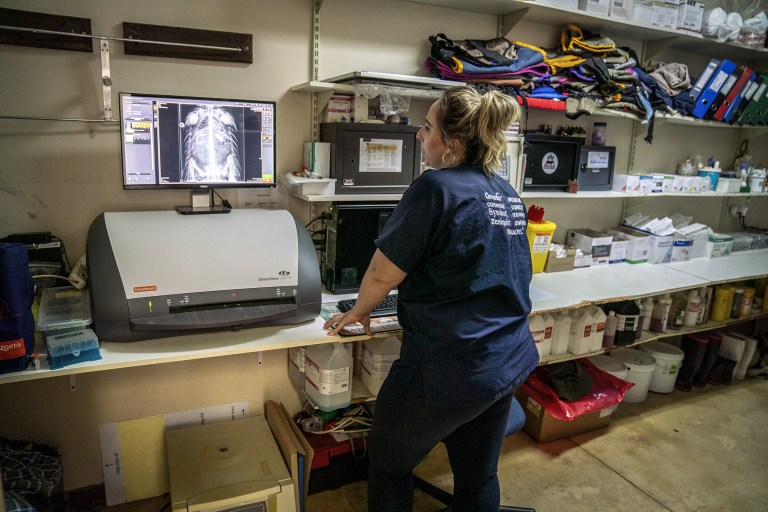
Dr Debbie English examines the x-ray of a rescued pangolin. (Photo: Shiraaz Mohamed)
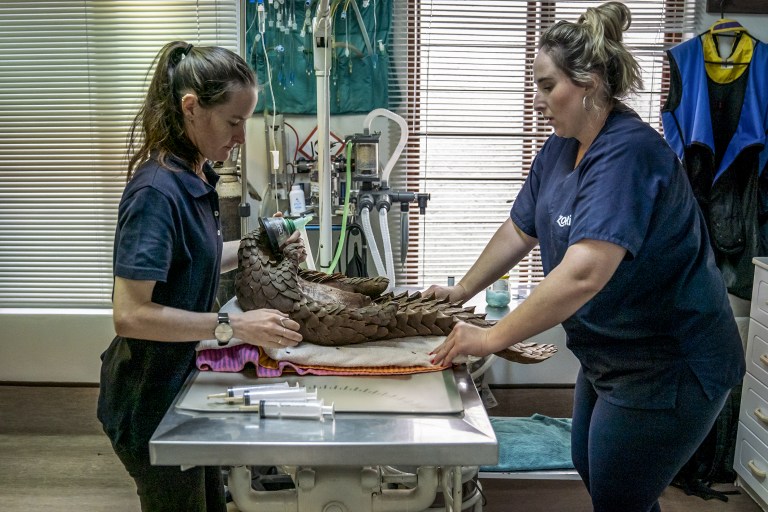
Dr Debbie English (right) and an assistant anaesthetise a rescued pangolin. (Photo: Shiraaz Mohamed)
Debbie English, one of two Provet vets in Limpopo specialising in pangolin treatment, describes parts of the process the rescued pangolins have to undergo. They are anaesthetised and put on a drip because of dehydration. Blood is drawn for tests and the animal is checked for wounds and injuries. Their internal organs are checked using x-ray, ultrasound and CT scan. Some of the animals are tube fed. They are constantly measured throughout their stay to monitor their progress.
“You look at these little animals lying under anaesthetic, with tubes in their mouths, monitors hooked up to them, drips running into them, and you just think, ‘What have they done to us to deserve this?’. It breaks your heart, but you know that it almost fuels you to carry on fighting for the next one that comes in. So it is incredibly hard and you take strain.”
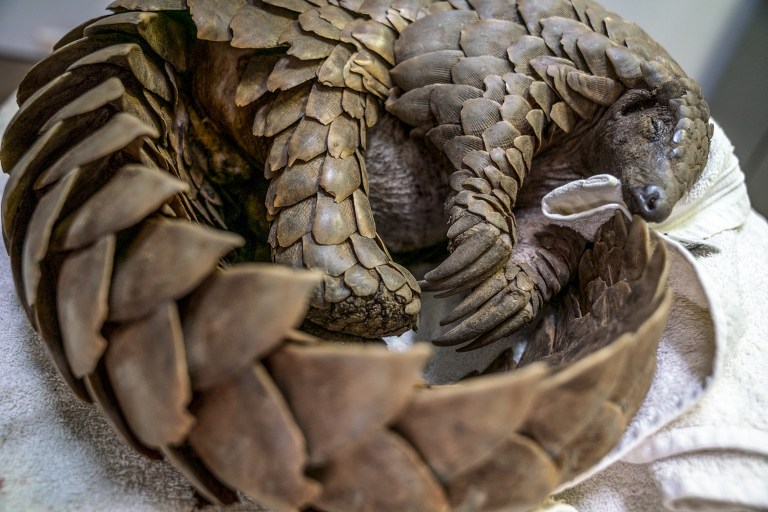
Anaesthetized pangolins asleep after it was tube fed. (Photo: Shiraaz Mohamed)
Complications
Rescued pangolins often have complications such as pneumonia because of the conditions they’ve been kept in. In captivity, they often lie in their own urine and faeces, causing their lungs to take severe strain. They can also suffer from biliary, making them anaemic, and blood transfusions need to be performed from one pangolin to another to save them.
One resilient pangolin, Lilly, was rescued from the trade and brought to English. She suffered from extreme dehydration and was emaciated. It was also discovered that Lilly was pregnant. “The first thing they do is they miscarry in captivity, with all the stress and in hospital environments, even in rehab. But we got her through that,” English says.
Lilly went through the medical and rehabilitation processes and was released back into the wild with her pup. But a year later she was intercepted after being poached again. She was returned to English and her team, but this time in a much worse condition. She survived hospitalisation and was sent for rehabilitation when she collapsed while out foraging for food.
She was rushed to the hospital and was treated for anaemia and given a blood transfusion, and after being monitored she was taken back for rehabilitation. But her caregivers were not satisfied with her progress and Lilly was returned to the hospital, where she was diagnosed with Immune Mediated Hemolytic Anaemia, a condition where the body starts attacking its own red blood cells. As a result, she lost her pup.
“She became more anaemic from that, on top of the actual biliary. So we had to do another blood transfusion on her, and put her on high doses of cortisone to try to suppress her immune system. It’s been a long road with her, but she’s doing really well now. I think she’s our toughest case, because literally everything under the sun that could go wrong with her went wrong,” English says.
Read more in Daily Maverick: “Pangolins: Scales of Injustice by Richard Peirce”
Back to the wild
Rescued pangolins can spend anything from a few days up to three weeks in ICU, depending on their condition. Only once the vets are happy with their progress are the pangolins sent for rehabilitation in preparation for release back into the wild.
Housed off site in a secure location, Umoya Khulula Wildlife Centre facilitates the rehabilitation process. According to Umoyo’s Emma de Jager, “In the last four years we’ve seen such an influx in the poaching of these animals.”
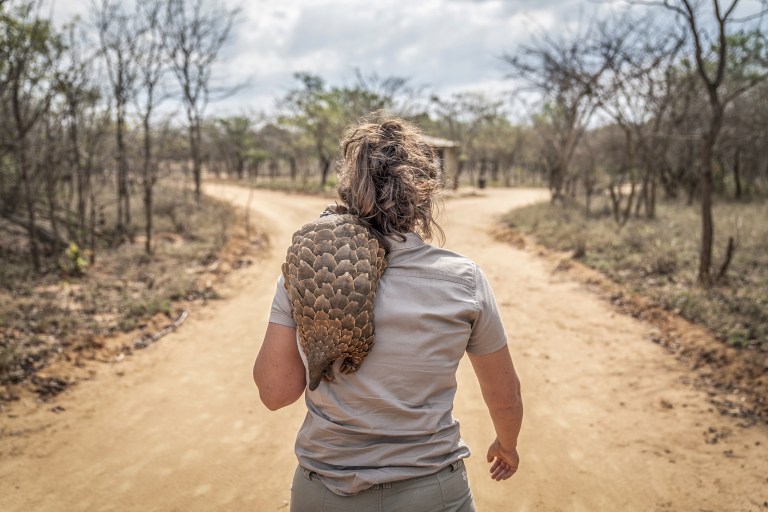
Emma de Jager takes a pangolin on a foraging expedition. (Photo: Shiraaz Mohamed)
Pangolins, unlike most other creatures, will not feed in captivity, posing a challenge in the rehabilitation process. The only way for them to feed is for them to forage for themselves. They only eat ants and termites, and they’re very specific about the type of ants they consume.
So they are taken out to forage daily, for five to six hours at a time. Pangolins are primarily nocturnal, which means they can forage late into the evening, especially in summer. De Jager and her colleagues go out and dig up ant nests for the younger pangolins, which are unable to forage on their own.
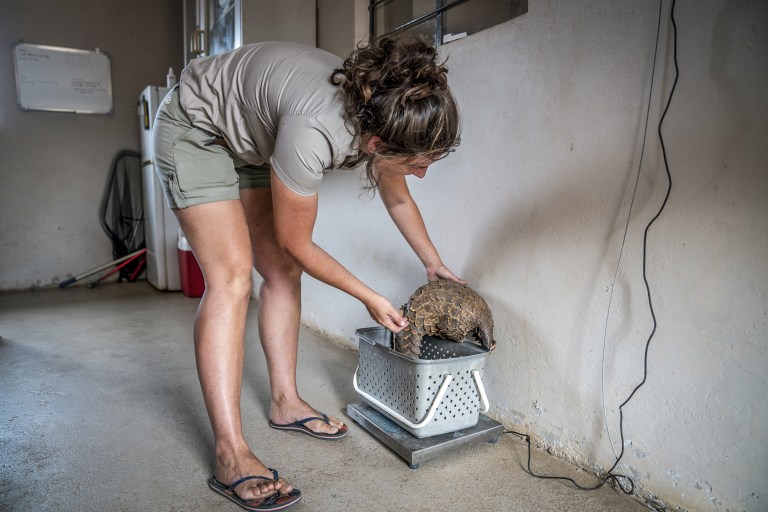
Emma de Jager measures the weight of a pangolin before it is taken out to forage. To measure their progress, weight is taken before and after foraging. (Photo: Shiraaz Mohamed)
Pangolins can be in rehab from three weeks up to nine months. “This is not a quick process for a lot of them, especially if they come in very young,” De Jager says.
Release sites
The search for a release site begins once the pangolin is stronger and in good health and begins to gain weight in rehab.
The release of pangolins into the wild is a difficult procedure. For the animal to adapt, suitable locations must be found. Several factors are considered – sites must be within pangolins’ natural distribution, where food and shelter are available, where the animal can be safe, and where the animal will not interfere with the natural population of pangolins, disrupting the wildlife population.
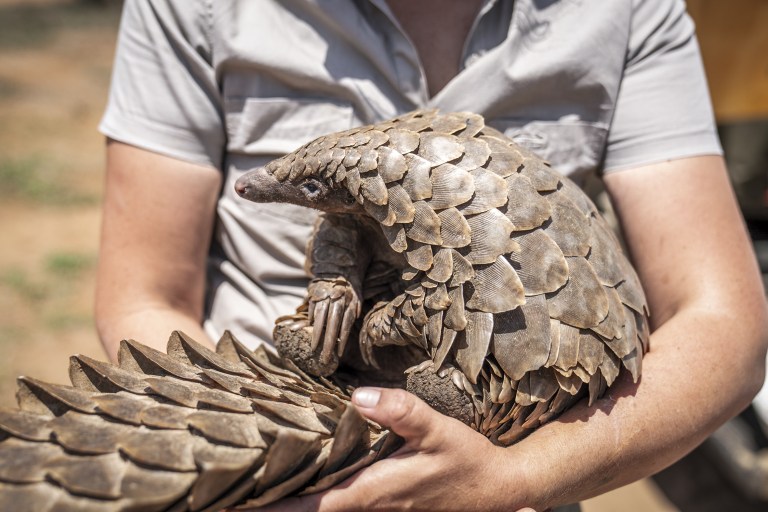
Emma de Jager holds a rescued pangolin. (Photo: Shiraaz Mohamed)
Each released pangolin is fitted with satellite and VHF (very high frequency) tags to help track its movements. This can also provide valuable data to researchers.
A pangolin is housed in a box for a few days after being transported to a release location. Every night, it is brought out for a walk, with the monitoring team following from a safe distance. The team observes its natural behaviour, such as whether the pangolin can locate shelter and food. They watch how the pangolin reacts to its new surroundings. While pangolins do not require much water, watching them drink is considered a bonus by monitors and researchers.
“Once we see those few signs and we’re happy that they’ve settled, we release them. There is an intense period of monitoring that follows, so the next day we will go to monitor them in the morning and in the evening. And again looking out for all the signs and just observing their physical behaviour, while collecting information,” Meyer says.
The pangolins are weighed frequently at the beginning as it is one of the only few indicators of its health. An animal might eat, but it could be fighting an internal infection. Monitors could observe that the animal is eating, but that will not necessarily mean that it is maintaining weight or condition. Scat samples are taken, which is a non-evasive method for further research and assessing their health.
In cases where a pangolin is physically healthy but mentally traumatised, human interaction is almost entirely removed and monitors rely on satellite tags to track its movements. Trail cameras with motion sensors are especially useful since they give crucial information to researchers and monitors while they are not in the field. The cameras are strategically positioned near the pangolin’s burrow.
The pangolins are followed for up to four months, with the monitoring team reducing their hands-on time. They start weighing them less and obtaining fewer visuals until they restrict physical contact with the animal to once a week or once every two weeks. If no further illness is detected or the animal is not going to be observed for research, as in Meyer’s case, the tags are removed and the pangolin is deemed to be rewilded.
George*, who works for Transfrontier Africa (*not his real name as he is involved in undercover sting operations to catch pangolin poachers), concludes: “We don’t know enough about these animals in order to be able to say, what we’re doing now is groundbreaking work. We need to develop a database of information so we can make more educated decisions for conservation and to prevent the illegal trade from growing exponentially.” DM/OBP
Back to the wild: The painstaking, often heartbreaking process of returning poached pangolins to their natural habitat

A rescued pangolin receives treatment. (Photo: Shiraaz Mohamed)
By Shiraaz Mohamed | 19 Feb 2023
In part two of our series on pangolin poaching, we look at what it takes to rehabilitate and release back into the wild a pangolin rescued from the illegal wildlife trade.
_________________________________________________________________________________________________________________________
It’s late at night and researcher Francois Meyer and wildlife monitor Hannah Sharp stand in the bush on a Big Five game reserve in the heart of Limpopo. They have been waiting since early afternoon for Bumper, a young sub-adult male pangolin, to come out of his burrow so they can weigh him and collect scat (faecal droppings) samples for Meyer’s research.
Read Part one above: The Sting: Meet the men and women risking their lives to save pangolin from being trafficked through a global criminal network
Meyer holds a master’s degree in zoology and is currently working towards a PhD focusing on pangolins rescued from the illegal wildlife trade with a particular interest in how captivity, rehabilitation and release affect the animals’ stress levels compared with the stress they experience in their natural environment.

A rescued pangolin forages for food in Limpopo. (Photo: Shiraaz Mohamed)
On the reserve, the only source of light comes from their cellphones and torches. Being on a Big Five game reserve makes them vulnerable to animal encounters. Meyer has had close encounters with a cheetah as well as an elephant bull in musth. While Meyer escaped unscathed, the bull damaged his Land Rover.
“Don’t worry, if there is any sign of trouble, we will pick it up on Silver’s behaviour,” Meyer assures Daily Maverick, as he smiles at his dog.
Bumper eventually makes his way out of his burrow, and Meyer and Sharp follow from a distance. They wait for the ideal moment to collect his scat samples and to measure his weight. But Bumper makes his way to a new burrow and settles in. Moments later a storm hits. Although disappointed that he was unable to collect his samples, Meyer seems delighted at Bumper’s behaviour. “It is as if he knew the storm was coming, so he went into a more suited burrow,” Meyer says.

A pangolin forage usually lasts five to six hours. (Photo: Shiraaz Mohamed)
Bumper is one of hundreds of pangolins rescued from the illegal wildlife trade. He was intercepted at the Beitbridge Border Post after a poacher tried to smuggle him into South Africa from Zimbabwe. He was flown by helicopter to receive specialist medical care and was eventually released into the bush as part of his soft release programme. Bumper is named after the good Samaritan who sponsored the fuel for his flight.
“I’m very glad to report Bumper is doing really well and is adapting to the field. His behaviour is super healthy. Because he’s had human contact in the care of rehabilitation and the release process, he was habituated to humans. But now he’s losing his patience with people, which is fantastic because he’s losing that habituation and his wild instincts are on point,” says Meyer, whose testimony in court helped convict Bumper’s poacher. The poacher is now serving a six-year jail sentence.
Abuse in captivity
It doesn’t always go so well.
Pangolins rescued from poachers are often put under a huge amount of stress as they are subjected to all sorts of abuse while in captivity.

A rescued pangolin is anaesthetised before it is tube fed. (Photo: Shiraaz Mohamed)
For weeks at a time, they can be kept in the boots of cars, in boxes, wired mesh structures, bags and rucksacks, washing baskets and cardboard boxes. Some are covered in diesel or petrol, or strong-smelling substances, to go undetected by sniffer dogs. They are sometimes tied up so they cannot escape and there have been cases of their limbs being cut off to prevent them from escaping.
Read more in Daily Maverick: “Standing up for the pangolin, the world’s most trafficked mammal”
Glen Thompson, a pangolin specialist for the conservationist group Transfrontier Africa, recounts how he encountered a pangolin with a missing foreleg. The pangolin was found at a roadblock in Hammanskraal.
“I took the animal to hospital and as we tried to anaesthetise it to assess it, we discovered its right forearm was missing. There were maggot larvae and the distinct smell of decaying flesh … I was in tears, I had to actually leave the theatre room. Even though it was the most humane thing (euthanising it) to do, it was heartbreaking. It is the most severe case I have seen. I have dealt with horrific cases, but this to me sticks out in my memory the most. Just the pain and suffering it went through.”
Specialist treatment
Pangolins that are rescued in sting operations are taken to specialist hospitals or veterinarians for assessment and treatment before they are released back into the wild.
Provet, a specialist practice in Limpopo, serves as a first-response vet for many sting operations in the area.

Dr Debbie English examines the x-ray of a rescued pangolin. (Photo: Shiraaz Mohamed)

Dr Debbie English (right) and an assistant anaesthetise a rescued pangolin. (Photo: Shiraaz Mohamed)
Debbie English, one of two Provet vets in Limpopo specialising in pangolin treatment, describes parts of the process the rescued pangolins have to undergo. They are anaesthetised and put on a drip because of dehydration. Blood is drawn for tests and the animal is checked for wounds and injuries. Their internal organs are checked using x-ray, ultrasound and CT scan. Some of the animals are tube fed. They are constantly measured throughout their stay to monitor their progress.
“You look at these little animals lying under anaesthetic, with tubes in their mouths, monitors hooked up to them, drips running into them, and you just think, ‘What have they done to us to deserve this?’. It breaks your heart, but you know that it almost fuels you to carry on fighting for the next one that comes in. So it is incredibly hard and you take strain.”

Anaesthetized pangolins asleep after it was tube fed. (Photo: Shiraaz Mohamed)
Complications
Rescued pangolins often have complications such as pneumonia because of the conditions they’ve been kept in. In captivity, they often lie in their own urine and faeces, causing their lungs to take severe strain. They can also suffer from biliary, making them anaemic, and blood transfusions need to be performed from one pangolin to another to save them.
One resilient pangolin, Lilly, was rescued from the trade and brought to English. She suffered from extreme dehydration and was emaciated. It was also discovered that Lilly was pregnant. “The first thing they do is they miscarry in captivity, with all the stress and in hospital environments, even in rehab. But we got her through that,” English says.
Lilly went through the medical and rehabilitation processes and was released back into the wild with her pup. But a year later she was intercepted after being poached again. She was returned to English and her team, but this time in a much worse condition. She survived hospitalisation and was sent for rehabilitation when she collapsed while out foraging for food.
She was rushed to the hospital and was treated for anaemia and given a blood transfusion, and after being monitored she was taken back for rehabilitation. But her caregivers were not satisfied with her progress and Lilly was returned to the hospital, where she was diagnosed with Immune Mediated Hemolytic Anaemia, a condition where the body starts attacking its own red blood cells. As a result, she lost her pup.
“She became more anaemic from that, on top of the actual biliary. So we had to do another blood transfusion on her, and put her on high doses of cortisone to try to suppress her immune system. It’s been a long road with her, but she’s doing really well now. I think she’s our toughest case, because literally everything under the sun that could go wrong with her went wrong,” English says.
Read more in Daily Maverick: “Pangolins: Scales of Injustice by Richard Peirce”
Back to the wild
Rescued pangolins can spend anything from a few days up to three weeks in ICU, depending on their condition. Only once the vets are happy with their progress are the pangolins sent for rehabilitation in preparation for release back into the wild.
Housed off site in a secure location, Umoya Khulula Wildlife Centre facilitates the rehabilitation process. According to Umoyo’s Emma de Jager, “In the last four years we’ve seen such an influx in the poaching of these animals.”

Emma de Jager takes a pangolin on a foraging expedition. (Photo: Shiraaz Mohamed)
Pangolins, unlike most other creatures, will not feed in captivity, posing a challenge in the rehabilitation process. The only way for them to feed is for them to forage for themselves. They only eat ants and termites, and they’re very specific about the type of ants they consume.
So they are taken out to forage daily, for five to six hours at a time. Pangolins are primarily nocturnal, which means they can forage late into the evening, especially in summer. De Jager and her colleagues go out and dig up ant nests for the younger pangolins, which are unable to forage on their own.

Emma de Jager measures the weight of a pangolin before it is taken out to forage. To measure their progress, weight is taken before and after foraging. (Photo: Shiraaz Mohamed)
Pangolins can be in rehab from three weeks up to nine months. “This is not a quick process for a lot of them, especially if they come in very young,” De Jager says.
Release sites
The search for a release site begins once the pangolin is stronger and in good health and begins to gain weight in rehab.
The release of pangolins into the wild is a difficult procedure. For the animal to adapt, suitable locations must be found. Several factors are considered – sites must be within pangolins’ natural distribution, where food and shelter are available, where the animal can be safe, and where the animal will not interfere with the natural population of pangolins, disrupting the wildlife population.

Emma de Jager holds a rescued pangolin. (Photo: Shiraaz Mohamed)
Each released pangolin is fitted with satellite and VHF (very high frequency) tags to help track its movements. This can also provide valuable data to researchers.
A pangolin is housed in a box for a few days after being transported to a release location. Every night, it is brought out for a walk, with the monitoring team following from a safe distance. The team observes its natural behaviour, such as whether the pangolin can locate shelter and food. They watch how the pangolin reacts to its new surroundings. While pangolins do not require much water, watching them drink is considered a bonus by monitors and researchers.
“Once we see those few signs and we’re happy that they’ve settled, we release them. There is an intense period of monitoring that follows, so the next day we will go to monitor them in the morning and in the evening. And again looking out for all the signs and just observing their physical behaviour, while collecting information,” Meyer says.
The pangolins are weighed frequently at the beginning as it is one of the only few indicators of its health. An animal might eat, but it could be fighting an internal infection. Monitors could observe that the animal is eating, but that will not necessarily mean that it is maintaining weight or condition. Scat samples are taken, which is a non-evasive method for further research and assessing their health.
In cases where a pangolin is physically healthy but mentally traumatised, human interaction is almost entirely removed and monitors rely on satellite tags to track its movements. Trail cameras with motion sensors are especially useful since they give crucial information to researchers and monitors while they are not in the field. The cameras are strategically positioned near the pangolin’s burrow.
The pangolins are followed for up to four months, with the monitoring team reducing their hands-on time. They start weighing them less and obtaining fewer visuals until they restrict physical contact with the animal to once a week or once every two weeks. If no further illness is detected or the animal is not going to be observed for research, as in Meyer’s case, the tags are removed and the pangolin is deemed to be rewilded.
George*, who works for Transfrontier Africa (*not his real name as he is involved in undercover sting operations to catch pangolin poachers), concludes: “We don’t know enough about these animals in order to be able to say, what we’re doing now is groundbreaking work. We need to develop a database of information so we can make more educated decisions for conservation and to prevent the illegal trade from growing exponentially.” DM/OBP
"Education is the most powerful weapon which you can use to change the world." Nelson Mandela
The desire for equality must never exceed the demands of knowledge
The desire for equality must never exceed the demands of knowledge
- Lisbeth
- Site Admin
- Posts: 67571
- Joined: Sat May 19, 2012 12:31 pm
- Country: Switzerland
- Location: Lugano
- Contact:
Re: Threats to Pangolins & Pangolin Conservation
Hawks arrest suspect for dealing in endangered species (pangolin)
2023/05/18
Media Statement
Directorate for Priority Crimes Investigation (HAWKS)
LIMPOPO – Collaborative efforts to curb the scourge of wildlife trafficking between the Hawks’ Serious Organised Crime Investigation, CIC National Security, D-Dass and Hoedspruit Farmawatch resulted in the arrest of a 59-year-old suspected pangolin dealer in Gravelotte outside Tzaneen on 17 May 2023.
The team received a tip-off about a suspect who was allegedly on the way to sell a pangolin in Hoedspruit. Without any waste of time, the team followed up on the information and a suspicious vehicle was spotted in Gravelotte.
Upon stopping and searching the suspicious vehicle, the team found a pangolin valued at R150 000-00 hidden in the boot inside the bag. The suspect failed to produce a permit for being in possession of a pangolin and was immediately placed under arrest.
The suspect is expected to appear in the Namakgale Magistrate Court’s tomorrow, 19 May 2023 to face charges relating to illegal dealing in endangered species (pangolin).
Enquiries:
Lieutenant Colonel Matimba Maluleke
071 481 3488
https://www.saps.gov.za/newsroom/msspee ... 3A9TD5E0Pg
2023/05/18
Media Statement
Directorate for Priority Crimes Investigation (HAWKS)
LIMPOPO – Collaborative efforts to curb the scourge of wildlife trafficking between the Hawks’ Serious Organised Crime Investigation, CIC National Security, D-Dass and Hoedspruit Farmawatch resulted in the arrest of a 59-year-old suspected pangolin dealer in Gravelotte outside Tzaneen on 17 May 2023.
The team received a tip-off about a suspect who was allegedly on the way to sell a pangolin in Hoedspruit. Without any waste of time, the team followed up on the information and a suspicious vehicle was spotted in Gravelotte.
Upon stopping and searching the suspicious vehicle, the team found a pangolin valued at R150 000-00 hidden in the boot inside the bag. The suspect failed to produce a permit for being in possession of a pangolin and was immediately placed under arrest.
The suspect is expected to appear in the Namakgale Magistrate Court’s tomorrow, 19 May 2023 to face charges relating to illegal dealing in endangered species (pangolin).
Enquiries:
Lieutenant Colonel Matimba Maluleke
071 481 3488
https://www.saps.gov.za/newsroom/msspee ... 3A9TD5E0Pg
"Education is the most powerful weapon which you can use to change the world." Nelson Mandela
The desire for equality must never exceed the demands of knowledge
The desire for equality must never exceed the demands of knowledge
- Richprins
- Committee Member
- Posts: 76096
- Joined: Sat May 19, 2012 3:52 pm
- Location: NELSPRUIT
- Contact:
Re: Threats to Pangolins & Pangolin Conservation
Locusts! 
Please check Needs Attention pre-booking: https://africawild-forum.com/viewtopic.php?f=322&t=596
- RogerFraser
- Site Admin
- Posts: 6003
- Joined: Wed Sep 18, 2013 9:36 pm
- Country: South Africa
- Location: Durban
- Contact:
Re: Threats to Pangolins & Pangolin Conservation
Four more suspects bust in possession of a pangolin
https://www.saps.gov.za/newsroom/msspee ... ?nid=46467
Media Statement
Directorate for Priority Crime Investigation
(HAWKS)
NORTH WEST – Four more suspects aged between 43 and 59 were arrested in Vryburg on 02 June 2023, after being found in possession of a Pangolin.
It is alleged that the suspects were headed to Mahikeng to meet a buyer for a Pangolin that they were selling for R60 000, when they were stopped by members of the Hawks’ Serious Organised Crime Investigation and members of SAPS Tactical Response Team along Vryburg Road.
In the boot of the vehicle, the team found a bag containing a Pangolin. The vehicle was seized for further investigation and the Pangolin was handed over to members of Nature Conservation.
The suspects will appear before Mmabatho Magistrate’s Court on 05 June 2023 for contravention of the National Environmental Management Biodiversity Act 10 of 2004.
Meanwhile, the case against Teboho Kodwa (28), Deon Mubhada (33) Kabelo Batsi (36) and Lesego Siana (45), who were arrested in possession of two Pangolins in Mahikeng has been adjourned to 06 June 2023.
Ends
Enquiries:
Captain Tlangelani Rikhotso
082 770 5045
https://www.saps.gov.za/newsroom/msspee ... ?nid=46467
Media Statement
Directorate for Priority Crime Investigation
(HAWKS)
NORTH WEST – Four more suspects aged between 43 and 59 were arrested in Vryburg on 02 June 2023, after being found in possession of a Pangolin.
It is alleged that the suspects were headed to Mahikeng to meet a buyer for a Pangolin that they were selling for R60 000, when they were stopped by members of the Hawks’ Serious Organised Crime Investigation and members of SAPS Tactical Response Team along Vryburg Road.
In the boot of the vehicle, the team found a bag containing a Pangolin. The vehicle was seized for further investigation and the Pangolin was handed over to members of Nature Conservation.
The suspects will appear before Mmabatho Magistrate’s Court on 05 June 2023 for contravention of the National Environmental Management Biodiversity Act 10 of 2004.
Meanwhile, the case against Teboho Kodwa (28), Deon Mubhada (33) Kabelo Batsi (36) and Lesego Siana (45), who were arrested in possession of two Pangolins in Mahikeng has been adjourned to 06 June 2023.
Ends
Enquiries:
Captain Tlangelani Rikhotso
082 770 5045
- Lisbeth
- Site Admin
- Posts: 67571
- Joined: Sat May 19, 2012 12:31 pm
- Country: Switzerland
- Location: Lugano
- Contact:
Re: Threats to Pangolins & Pangolin Conservation
Two less 

"Education is the most powerful weapon which you can use to change the world." Nelson Mandela
The desire for equality must never exceed the demands of knowledge
The desire for equality must never exceed the demands of knowledge


